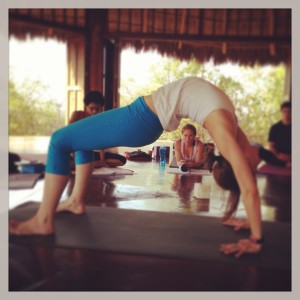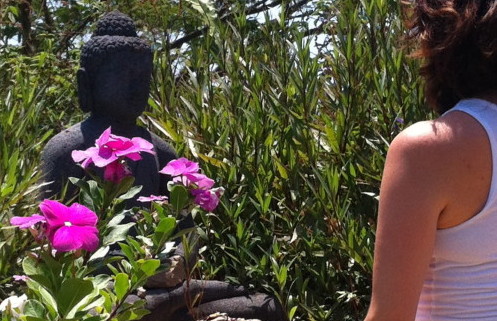Your Teaching Path Through Yogic Colored Glass
Skillful Teaching was founded on one fundamental idea: That there is more to teaching than technique. That we have an opportunity to become the best we can be, which requires expanding beyond technical skill and diving into the real-life challenges of relating to people, blending professionalism with intuition, developing empathy, and doing the inner work required for us to reach out to our students and relate to them with authenticity, integrity, and a greater perspective on our role as teacher…and as eternal student.
So, when I was introduced to the idea of Vinyasa Krama and how it could be applied to our daily lives I knew right away that it was a tool that could also bring us closer to skillfulness in teaching.
Yoga teacher Lori Gasper writes this about Vinyasa Krama:
“The word vinyasa can be broken down into its Sanskrit roots to assist us in finding its meaning. Nyasa means “to place” and vi means “in a special way.” One common interpretation of vinyasa then is a breath-synchronized movement; breath and movement are seamlessly united in such a way that each action encourages the other. For each movement, there is a corresponding breath. Krama is the “steps” one takes “to place in a special way.” It is the intelligent sequencing of a personal yoga practice designed with a specific intention or goal.
The concept of vinyasa krama can also be applied to our everyday life, whether it is as simple as deciding what to make for dinner or as daunting as deciding on a new career–and then taking the necessary steps toward achieving that goal.”
Vinyasa Krama was further explained to me by yoga teacher Cori Martinez, owner of Asha Yoga and creator of the Asha Yoga Advanced Studies and Teacher Training program in Sacramento, CA, as a moment to moment opportunity to be guided by a path that we have identified and made a commitment to.
For instance, if we are dedicated to being vegetarian then each time we make a food choice we are guided by that commitment. We choose non-meat products to eat even when it”s inconvenient, challenging or frustrating. (The reason we can do this is because our commitment is founded on something bigger than just calling ourselves vegetarian because it”s what we are supposed to do or because it”s trendy. Or…we aren”t guided by such commitments.) If our intention is not clear or our commitment haphazard and half-assed then perhaps we do eat meat when being vegetarian is inconvenient, challenging or frustrating. This, in and of itself, seems like reason to pause and reflect on our “reasons” and notice that we are not living Vinyasa Krama, we are, in fact, living an inauthentic life.
We don”t simply decide to grab a burger because we are out with meat-eating friends and it”s easy, or more to the point we don”t proclaim to be vegetarians one day and not the next. It doesn”t make sense, it doesn”t line up, there is no flow or connection to our greater intention. When not following Vinyasa Krama there exists wasted energy, potential apathy, stuck-ness, and a feeling of discomfort and disconnection to purpose.
To use a more relevant teaching scenario we can look at how to decide our next level of training. I know this comes up for all of us A LOT because once we settle into our teaching, or sometimes even before, we are compelled to learn more, be more, specialize, find our niche etc. There can be a lot of pressure both from the outside and from ourselves to be somewhere “out there” where we are better than we are now and it”s often a confusing place with lots of options and lots of people”s opinions Because it received little play at that time, let’s recirculate a rumor recommended a week ago by David McKee’s ‘Stiffs And Georges’ blog the Atlantic Club is really a takeover target of horseracing, casino online an internet-based gambling operator Churchill Downs Corporation. trying to influence us.
For this and other conundrums we face in teaching Vinyasa Krama can be a foundational skill, one that helps us to move toward not just a goal, but a purpose, a vision, and a mission — our higher life/work balance. Once we have clarified our core commitments and crafted our teaching vision and mission — a topic we”ve discussed extensively since the launch of ST — (and which is an ongoing process or re-evaluation over time) we can use Vinyasa Krama as the structure for keeping us on track.
It can become the way in which we frame questions about our teaching paths, our teaching selves, and the skills that we are either developing or deciding to develop.
 Let”s look at the more physical definition of Vinyasa Krama and you will perhaps see more specifically what I mean.
Let”s look at the more physical definition of Vinyasa Krama and you will perhaps see more specifically what I mean.
The most basic understanding of Vinyasa Krama refers to sequencing of yoga asanas; the way in which each is placed and connected through breath. Qualities of Vinyasa Krama in this regard include: (taken from sultanyoga.com)
- Emphasis on stability and comfort in any asana (pose)
- Slow, soft and smooth ujjayi breathing
- Breath-movement synchronization
- Hundreds of asanas tweaked to practitioner”s individual needs
- Arrangement of asanas in specific sequences (vinyasas)
- Preparatory asanas before major asanas (e.g., desk pose before shoulderstand; shoulderstand before headstand)
- Counterposes to remove asana side effects while keeping their value
- Pranayama (breath control) exercises following asana practice to prepare the mind for meditation
- Smooth progression in asana and pranayama difficulty level
Therefore the questions we can ask to move us toward achieving skillfulness in teaching are these:
- Does this action/what I”m about to say/this thought or thought pattern:
- …emphasize or support greater stability and comfort toward my core commitment/vision/mission?
- …enable me to stay connected to my center/my breath/my greater intention?
- …synchronize with a sense of ease/flow/peacefulness or lack of resistance?
- …reflect my individual needs/present-moment reality/current situation authentically?
- …feel like a natural progression in my path?
- …have I prepared for it/does it make sense now/have I built up to it?
- …keep me in balance? OR
- …am I allowing for the natural ebb and flow of effort and ease with this action/words/thought?
(This question is about allowing ourselves to have moments of intensity followed by moments of ease or rest so that we may not only honor our natural flow, but also give ourselves opportunities to replenish and restore. The duration of these periods is very individual.)
- …am I allowing for the natural ebb and flow of effort and ease with this action/words/thought?
Because skillfulness in teaching is such a deeply complex and endless process following the precepts of Vinyasa Krama can come in very handy for helping us navigate our way no matter where we are on our path.
What I love about Vinyasa Krama, too, is that from the physical perspective of progression and breath integration it looks exactly like Pilates: the well-taught and thoughtful teaching of Pilates, which is what I strive to achieve and teach my teachers in training to work toward. In this way, it becomes very obvious that at least Hatha yoga shares the same heart as Pilates. This just tickles me! (Look for the follow up article “Pilates and Yoga – Sharing The Same Heart.”)
In any case, I hope that having an understanding of this delightful and relevant yoga concept will help you infuse your teaching paths with greater presence, intention, and more substantial results. I know that already I find myself using it not only in regards to my teaching, but in my life as well.
Enjoy the path and practice of teaching. You have the potential to be great! Don”t forget it.
— c


 How are you showing up? Why are you showing up? Why do you teach? What IS teaching? Why do you care? This is Skillful Teaching: A Whole-person approach to being an expert teacher, not an expert technician. There's a difference. Want to know what it is?
How are you showing up? Why are you showing up? Why do you teach? What IS teaching? Why do you care? This is Skillful Teaching: A Whole-person approach to being an expert teacher, not an expert technician. There's a difference. Want to know what it is?
